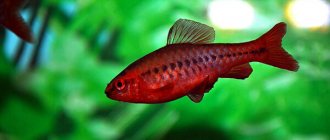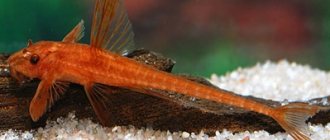How to determine the sex of a goldfish
Photo of the structure of a goldfish
At the end of the spawning period and after several seasons of spawning, some males have a hard chest area.
Here are a few more ways to determine the sex of a goldfish, but even they are useless if the fish is not at least a year old*, that is, if the fish has not reached sexual maturity.
1. Males have a growth that extends through the back of the pelvic fin to the anus. In females this growth is either completely absent or much smaller.
2. In females, the area between the ventral and anal fins is soft, while in males it is hard.
3. Although it is difficult to see, the anus of females is round and convex, while the anus of males is thinner and concave.
4. The male's pelvic fins are pointed, while the female's pelvic fins are round and shorter.
5. The color of females is brighter and they are more active.
6. You can introduce a female goldfish into the aquarium and observe the reaction of the other goldfish. The males will swim up to the new fish and chase it.
* Don’t be surprised if in a pet store, when buying goldfish, when you ask, give a male and a female, they will tell you that this is not possible! Sexual differences in the goldfish family appear only with the onset of maturity, i.e. after 1 year.
Source
Gourami
Gourami is another fish species that is not easy to identify. Males and females often have the same coloring and shape. However, there is one fairly universal sexual difference observed in most gourami species. The dorsal fin is long in males, while the dorsal fin in females is shorter and rounded.
Additionally, some gourami species show color differences between the sexes. The male pearl gourami has a deep red-orange coloration on the throat and chest. Male moon gourami have orange to red ventral fins. As with the betta, many gouramis build a bubble nest, but both the male and female are involved in caring for the eggs.
How to determine the sex of a goldfish
Photo of the structure of a goldfish
At the end of the spawning period and after several seasons of spawning, some males have a hard chest area.
Here are a few more ways to determine the sex of a goldfish, but even they are useless if the fish is not at least a year old*, that is, if the fish has not reached sexual maturity.
1. Males have a growth that extends through the back of the pelvic fin to the anus. In females this growth is either completely absent or much smaller.
2. In females, the area between the ventral and anal fins is soft, while in males it is hard.
3. Although it is difficult to see, the anus of females is round and convex, while the anus of males is thinner and concave.
4. The male's pelvic fins are pointed, while the female's pelvic fins are round and shorter.
5. The color of females is brighter and they are more active.
6. You can introduce a female goldfish into the aquarium and observe the reaction of the other goldfish. The males will swim up to the new fish and chase it.
* Don’t be surprised if in a pet store, when buying goldfish, when you ask, give a male and a female, they will tell you that this is not possible! Sexual differences in the goldfish family appear only with the onset of maturity, i.e. after 1 year.
Source
Compatibility
Slow pets feel good in species aquariums. Tropical fish and goldfish cannot live together due to differences in housing conditions. Veil fish need cooler water.
The best neighbors for veiltails are other short-bodied golden ones: telescopes, orandas, ryukins, red caps, etc.
It is unfortunate that goldfish live next to aggressors that try to injure their fins (barbs, tetragonopterus, thorns) and small breeds associated with live food.
Veiltails get along well with ancitrus, speckled catfish, peaceful representatives of related breeds of goldfish with a short body - pearls, orandas, lionheads, telescopes.
Goldfish compatibility chart.
How to determine the sex of a goldfish
Photo of the structure of a goldfish
At the end of the spawning period and after several seasons of spawning, some males have a hard chest area.
Here are a few more ways to determine the sex of a goldfish, but even they are useless if the fish is not at least a year old*, that is, if the fish has not reached sexual maturity.
1. Males have a growth that extends through the back of the pelvic fin to the anus. In females this growth is either completely absent or much smaller.
2. In females, the area between the ventral and anal fins is soft, while in males it is hard.
3. Although it is difficult to see, the anus of females is round and convex, while the anus of males is thinner and concave.
4. The male's pelvic fins are pointed, while the female's pelvic fins are round and shorter.
5. The color of females is brighter and they are more active.
6. You can introduce a female goldfish into the aquarium and observe the reaction of the other goldfish. The males will swim up to the new fish and chase it.
* Don’t be surprised if in a pet store, when buying goldfish, when you ask, give a male and a female, they will tell you that this is not possible! Sexual differences in the goldfish family appear only with the onset of maturity, i.e. after 1 year.
Source
When is it easier to find out the gender of a goldfish?
Before puberty, it is almost impossible to determine their gender. This usually occurs around the age of one year. During the spawning period, the situation begins to change - differences appear in males and females.
At this time, males begin to actively pursue females, being somewhat behind them, pressing them against the walls of the aquarium or decorative elements, against vegetation, in order to provoke spawning. True, a pair of males in an aquarium without a female presence will also chase each other.
How to distinguish goldfish: female from male
Let's consider what else you should pay attention to to determine the sex of these representatives of the crucian genus. It should be noted that almost all physiological and behavioral signs listed in this article refer to healthy individuals with normal nutrition.
After all, a sick male will not pursue a female during the mating season; a female that has been underfed will look shaped like a male; a bloated belly may be a symptom of a disease and not a sign of a female.
Video: how to distinguish the gender of goldfish
Growth
You should take a good look at your pets from below. Males have a noticeable outgrowth located between the back of the ventral fin and the anus. In females it is absent or barely noticeable.
The area between the ventral and anal fins
In females, the area between the pelvic and anal fins is soft to the touch, while in males it is hard.
Anal hole
To determine gender, it is recommended to carefully examine the anus. In female goldfish, it has a more roundish shape, and also protrudes slightly during the mating season. When viewed from the side, in females the anus looks like a bulge in the abdominal area.
Anal opening of a female
A little history
Goldfish belongs to an artificially bred species, is a freshwater fish, belongs to the carp family, the class of ray-finned fish. In historical documents, the first mentions of goldfish are found in the 6th century BC. e ., so, China is considered the birthplace of fish. The most noble families preferred to have the image of these fish on their coats of arms.
Some breeds were elevated to the rank of sacred. The history of breeding Bet breeds began with the Ming Dynasty.
Then breeding began in Korea in 1500, and in 1502 goldfish conquered Japan, then Indonesia. And in the 17th century, it was brought to Europe and settled in the royal pools as an overseas miracle .
Changing its original appearance in the process of breeding new breeds, the goldfish did not lose the habits of the crucian carp. She loves to dig, is unpretentious in food, prefers space in the aquarium and clean water.
At the moment, more than 300 species of goldfish are known, so the variations in the color and structure of the body, tail and fins are very diverse. Goldfish can have either a regular tail, similar to the tail of the ancestor of this breed - the crucian carp, or a double one. The most widely known are veiltails, oranda and lionheads. So, the choice of an inhabitant for an aquarium depends on the preferences of the aquarist.
After you have decided on the choice of fish breed, you should decide for what purpose the individual is purchased - for keeping or for keeping with further breeding.
The second option is more complicated, since you must purchase fish of a certain sex. Distinguishing a female goldfish from a male is quite a difficult task, but if you take into account the recommendations, it is completely solvable.
If you purchase fish before they reach puberty, it is recommended to purchase at least 6 fish of the same species. Once you reach maturity, you will have the best chance of owning fish of both sexes.
Habitat
Historically, guppies live in Central, northern South America and the Caribbean islands. These are countries such as Brazil, Venezuela, Guiana, Trinidad and Tobago. Thanks to their amazing endurance, the fish have inhabited almost all possible freshwater biotopes: rivers, lakes, canals, swamps. Some populations can be found even at the mouths of rivers flowing into the ocean, where mixing of fresh and salt water occurs.
They prefer warm rivers with gentle currents. The fish live in small schools (up to 10 pieces) in dense thickets of plants, where they hide in case of danger. They usually swim near the surface of the water.
Currently, guppies are a true cosmopolitan species. Thanks to artificial acclimatization to combat the larvae of the malaria mosquito, the fish can be found on all continents. The widespread use of fish as an aquarium pet also played an important role.
Editorial: Haplochromis boadzulu
Guppies are one of the hardiest fish, capable of living in a wide range of water parameters and surviving, sometimes, in extremely extreme conditions. It is reliably known that wild populations (probably released by aquarists) have adapted to live even in the rivers of large cities, in places where warm wastewater is discharged.
How to determine gender?
At approximately 12 months of age, the fish reaches puberty. Before reaching this age, it is not possible to distinguish between sexes. By the beginning of the spawning period, boys and girls begin to show distinctive characteristics.
It should be noted that there are varieties of fish in which females reach puberty after reaching 3 years of age. Therefore, the puberty factor depends on the variety of the individual you choose.
Although males during this period show maximum activity by chasing females, while pressing them against the walls of the aquarium or decorative objects, a pair of boys can also behave in a similar way in the absence of females.
You can recognize males by the changes that occur at this time, the appearance of growths. The growths appear in the area of the gills and pectoral fins and are white in color. On the pectoral fins you can see small notches, which are called “saw” due to their similarity with the instrument of the same name. A complication is the fact that the appearance of a growth may not occur in some males, while it may appear in females.
Tetras
Tetras have some differences between the sexes, which vary depending on the species. Females are slightly larger and plumper than males. Males are often more brightly colored and may have longer fins than their female counterparts. Tetras are schooling fish, so pairings can be obtained by simply purchasing a small school of them at a time. They usually reproduce as males, chasing the female and fertilizing the eggs when she lays them on plants or scatters them among rocks. There is no parental care for the eggs; if a fish finds them, they will eat them.
Main features
Let's look at the main signs of how to distinguish a boy from a girl, but these recommendations are applicable only to healthy individuals. An unhealthy male will not be able to be active in courting the female, and an underfed female will not have roundness; a swollen belly can, in turn, be a sign of the presence of a disease.
Let us list the main differences between males and females.
During the spawning period, a female goldfish can lay up to 3 thousand eggs. The duration of spawning is about 6 hours in the first half of the day.
Under home conditions, spawning can occur year-round, but in this case the breeding fish will become depleted. Therefore, at the end of spawning, it is recommended to provide the fish with rest by moving them into separate aquariums.
So, based on the above distinctive features, you can distinguish a male from a female and start breeding goldfish . To breed goldfish you will need 2-3 males, a female, a spawning aquarium with a volume of about 30 liters, aquarium plants, a good filtration and aeration system, and a thermostat. Further breeding also presents difficulties, but it should be remembered that the key to healthy offspring is good nutrition and fresh water.
You can learn more about the differences between female and male goldfish in the video presented.
Creating comfortable conditions for successful fish breeding
Before breeding goldfish, the spawning tank must be properly prepared and all favorable conditions must be created for subsequent spawning. First, a small number of plants with small leaves should be placed in the container that is intended to be used for propagation. For placement in the spawning tank, you can use plants such as hornwort, or for example, elodea. It is best to press all plants to the bottom of the container with a small weight.
Hornwort is a win-win option for landscaping spawning grounds.
In a spawning tank used for breeding and raising goldfish fry, instead of plants, you can alternatively place small bundles of finely plucked loofah. It should be noted that willow sponges cannot be used. Bunches of loofah are placed in the container in the same way as plants. Egg-laying fish, which include goldfish, unlike viviparous fish (for example, platies), do not give birth to live fry. They lay eggs, which adhere to plants or the surface of tufts of loofah. When a pregnant goldfish has spawned all its eggs, they can be removed from the spawning tank.
Some breeders use synthetic sponge fibers for spawning.
In addition, when breeding goldfish in a spawning area, you need to create comfortable conditions for spawning. To do this, you need to carefully monitor:
Veiltail lies at the bottom - reasons
This fish is unique, but it immediately makes you aware of uncomfortable conditions. If your pet lies down and begins to breathe heavily, you need to immediately find out the reasons and take action. Factors that support this behavior in veiltail fish:
- Adaptation
. When moving into a new home, the fish will need a little time to get used to the new environment and conditions. The adaptation will take no more than two days. - Not comfortable conditions
. Improper keeping of fish can also cause such consequences. - New aquarium or equipment
. Insufficient levels of microorganisms also have a negative impact on health, as does their excess. - Water quality
. Temperature, filtration, acid-base balance must be within normal limits for a particular type of fish. - Diseases
. Injuries or poor health cause the fish to sink to the bottom. It is necessary to identify the disease, transplant the fish into “quarantine” and begin treatment.
When is it easier to find out the gender of a goldfish?
Before puberty, it is almost impossible to determine their gender. This usually occurs around the age of one year. During the spawning period, the situation begins to change - differences appear in males and females.
At this time, males begin to actively pursue females, being somewhat behind them, pressing them against the walls of the aquarium or decorative elements, against vegetation, in order to provoke spawning. True, a pair of males in an aquarium without a female presence will also chase each other.
1. The gill covers and scales of females do not have wart formations like those of males; 2. The anal opening of the female before spawning thickens and swells - it becomes convex and clearly noticeable; 3. The strongly prominent rounded body of a goldfish During the spawning period, they also undergo external changes - small white growths, similar to millet, appear on the gills and pectoral fins, and small notches called “saws” are observed on a pair of pectoral fins. However, in some males the growths do not appear at all, but sometimes they can appear in females.
During this period, the female becomes rounded, her abdomen swells and becomes asymmetrical. The body of males has a thinner, streamlined shape. However, it is difficult to determine by body shape in some breeds (for example, Ryukin), since all their representatives have a rounded and swollen body.
Carp
Barbs and other representatives of the carp family are quite difficult to distinguish from each other. Differences will vary depending on the species, but in general, males are more intensely colored and slimmer than females. Since most cyprinids are schooling fish, one way to get a breeding pair is to buy a group of them. In some cyprinid species, including goldfish, males develop small white bumps (nuptial tubercles) on the head, operculum, and possibly on the spine of the pectoral fins during mating season. Males will chase a female who lays eggs, and the males will fertilize them as she lays them. After breeding, the eggs are usually not cared for and the parents may even eat them if found.
Reproduction
Veiltails become sexually mature at the age of one to two years. The readiness of the fish to spawn is usually easy to see: the males develop characteristic white tubercles, they become active and chase the females with eggs in their abdomen.
Before spawning, it is recommended to separate males and females for about a week, and feed them generously. Then, one day before the expected spawning, do not give food. To fertilize eggs, you need to place one female and two or three males in a separate aquarium; the water temperature should be slightly higher than usual for veil tails - approximately 25°C. This elevated temperature stimulates spawning and male activity.
After the female has laid all the eggs and the males have fertilized them, the adult fish must be removed from the aquarium. In a few days, the fry will appear, the first food for them will be “living dust” - the smallest plankton, the simplest microorganisms. Gradually, as the fry grow, they can be switched to live food, additionally given egg yolk and dry food. The feeding regimen at first is every 3-4 hours, by the month it can be switched to standard for veil tails twice a day.
Reviews
Aquarists share information about the characteristics of the breed and the nuances of keeping veiltails in their reviews.
I bought a pair of veil tails and put them in a 60 liter aquarium. Realizing that the container for gold was too small, I equipped it with a powerful filter. I feed the fish in the morning before work and in the evening in small portions, which are eaten in a couple of minutes. I change the water every Saturday and clean the bottom once a month. Pets are interesting to watch, they are constantly on the move. Olga, Moscow
The fish is visually impressive, but I found more disadvantages than advantages in it. At first I was disappointed in my expectations. The spotted veiltail soon turned orange. There is constant turbidity in the water, the aquarium quickly becomes dirty, and it is impossible to sleep at night due to the noise from the constant digging of the soil. My hobby ended when I sold the veil-tail. Michael
Before buying veil tails, I thoroughly prepared. I read special literature, equipped a large aquarium, and bought dry food for the golden ones. Three pets have been living with me for three years, and I have never regretted it. Yes, pets eat a lot and quickly pollute the water, but they are fabulously beautiful. Watching veiltails in the evenings relieves fatigue and nervous tension after work. Veronica
How to distinguish goldfish: female from male
Let's consider what else you should pay attention to to determine the sex of these representatives of the crucian genus. It should be noted that almost all physiological and behavioral signs listed in this article refer to healthy individuals with normal nutrition.
After all, a sick male will not pursue a female during the mating season; a female that has been underfed will look shaped like a male; a bloated belly may be a symptom of a disease and not a sign of a female.
Video: how to distinguish the gender of goldfish
Growth
You should take a good look at your pets from below. Males have a noticeable outgrowth located between the back of the ventral fin and the anus. In females it is absent or barely noticeable.
The area between the ventral and anal fins
In females, the area between the pelvic and anal fins is soft to the touch, while in males it is hard.
Anal hole
To determine gender, it is recommended to carefully examine the anus. In female goldfish, it has a more roundish shape, and also protrudes slightly during the mating season. When viewed from the side, in females the anus looks like a bulge in the abdominal area.
Anal opening of a female
It should also be taken into account that in females the fin near the anus is denser than in males.
Pelvic fins
On the belly of females, the fins are more round and somewhat shorter in size than those of males. In males, they are correspondingly larger and pointed.
Coloring
Females have a slightly brighter color. In addition, they behave more actively than males of this species. One of the distinctive features of males is the presence of small but clearly visible growths in the form of whitish tubercles in the area of the gill covers.
But when they are ripe, during the spawning period physiological signs and changes in behavior appear, based on the combination of which you can easily do this. If you want your goldfish to reproduce, you should buy several specimens, not a couple. Then the probability of having different-sex individuals is higher, but the aquarium, accordingly, then you should choose a larger size.
Cichlids
Cichlids are such a diverse group that it would take a short novel to detail the differences within each species. While many of them are not easy to differentiate, there are a few rules of thumb that apply to quite a few cichlid species.
Males are often slimmer but larger than females and have brighter colors. The dorsal and anal fins of the male are more pointed, larger and smoother than those of the female. In many species, males will have egg-shaped markings on their anal fin, known as egg spots. Some males have a bump on their head called a nuchal hump. Although females may develop a nuchal hump during spawning, it is never as noticeable as in males. Typically the dominant male has a larger neck hump than other males.
While the general rules above apply to many species of cichlids, if you plan to breed them, do your homework on specific species before looking for a mate.
History and Definition of Goldfish
Its ancestor is the common silver carp. This lover of fresh water was domesticated back in Ancient China. In fact, these are the first aquarium fish. But they didn’t stop at simply accustoming them to “home conditions”; they bred many breeds and varieties that differ in body shape, eyes, size and color.
This fish requires a lot of swimming space when kept in an aquarium. It is very hardy and suitable for decorative outdoor ponds. Prefers bright light and flocking together in a flock of their own kind. When designing a reservoir, it is better to use loose soil, driftwood, stones and living plants.
The male goldfish is very similar in appearance to the female, but only until puberty, which occurs in the second year of life. At this point, the male has a kind of “saw” on his front paired fins. By these notches you can already understand who is in front of you. And on the gill plates, peculiar pale bulges appear, similar to semolina. They are used during mating season - the male rubs them against the female.
Veiltail - diseases
The aquarium veiltail fish is resistant to many diseases. What diseases are common in veil tails:
- Overeating and obesity
. If you follow the correct diet and dose, this can be avoided. - Dermatomycosis, discoloration of scales
. Bacterial damage to the surface due to poor water quality. - Fin rot
. Characteristic of all fish with luxurious fins. Medicines prescribed by veterinarians are used. - Fungus
. Pathogenic microorganisms attack weakened fish and eggs.
Main differences, examples with photos
Males and females of Ternetius are almost the same from each other, so beginners often have difficulty determining the sex of the fish.
There are several signs that can help you successfully distinguish “boys” from “girls.”
Next, we will look at the signs of difference between ordinary Ternetias, using examples with photos, after viewing which it will immediately become clear how to distinguish a female from a male. The considered characteristics are fully applicable to other types of these fish:
Size
One of the main signs: females are almost always larger than males , since in the future they will have to bear eggs.
On the left is a female, on the right is a male.
Bettas
Bettas are a species of fish that is fairly easy to determine gender. Males have long, flowing fins and bright colors that attract owners. Females are not as brightly colored and have shorter fins, but some varieties of bettas may also have short fins. It is not always easy to find female bettas for sale in pet stores; if you can't find it, ask the store owner or manager if they can order it for you. Bettas should be kept separate from each other and from the female until she is ready to breed. The male builds a nest of air bubbles on the surface of the water and then entices the female to lay her eggs underneath by wrapping his body around hers to fertilize the eggs as she lays them. He then collects the eggs in his mouth and places them in his bubble nest. After breeding, the male drives the female away and cares for the eggs and young. The female must be removed from the aquarium, otherwise she will be attacked by the male.
The main differences between fish by gender, examples with photos
At first glance, males and females are no different from each other. However, if you study the fish more closely, you will notice that some individuals are a little different from others.
It is important to remember that young fish have weakly defined sexual characteristics, so only adult Danios (at least 3 months old) should be considered.
The differences listed below are given for the most popular species - Danio rerio ("stripe whale"), but, in essence, are characteristic of all varieties of Danio.
Size
The most obvious sign is the size and shape of the abdomen. In females it is always a little larger, since in the future they will have to bear eggs. It is important that the Danio’s tummy can stretch for other reasons: for example, in the case of a disease of the digestive system.
Males can also suffer from such diseases, so you need to pay attention to the very shape of the abdomen. In “girls” the abdomen is evenly curved, while with the disease the anterior part of the body is significantly prominent. We definitely recommend that all aquarists read this interesting and informative article about zebrafish diseases and their treatment.
Male above, female below.
Color
Another sign thanks to which you can easily distinguish males. “Boys”, as a rule, are colored more brightly and attractively, since they should attract the attention of “girls”.
Females, in turn, have a duller and more uniform color. Under natural conditions, pregnant females often hide from predators, so their faded coloring serves as their natural camouflage.
The photo shows that the veiled male Danio has a brighter color (the fish is below), unlike the female.
Behavior
In addition to their bright colors, males stand out for their character. “Boys” behave more active and mobile than “girls” - this is especially noticeable during the spawning period. Some individuals, as a rule, chase others or cut circles around them. It’s easy to guess that the male is the active partner, and the “victim” is the female.
How to determine the sex of a colored Glofish fish?
Glofish is another Ternetius breed that has an unusual color. Unlike Caramels, these fish received bright skin thanks to genetic modification. Regardless of the method of “repainting” the fish, its physical parameters remain unchanged. The aquarist needs to remember the following signs:
To correctly determine the sex, you must wait until the Glofish reaches the age of 7 months.
By the way , don’t forget to read an interesting article about the compatibility of Ternetius; before sharing with other species, you definitely need to know with whom they get along best.
Breeding process
To reproduce, a couple of fish must be placed in a separate container, the volume of which must be at least 20 liters. When breeding fish, several rules must be taken into account:
A mesh made of plastic must be attached to the spawning tank, approximately 2 centimeters from the surface of its bottom. This is necessary in order to preserve eggs from adults. After all , after spawning, goldfish can eat all the eggs. To speed up the reproduction process, in the spawning tank, after placing fish in it, the water temperature can be gradually increased by several degrees Celsius.
THIS METHOD GIVES GUARANTEES! GOLDEN SPAWNINGS!
Breeding goldfish. Practice.
After spawning, adults need to be removed from the spawning area. The temperature of the water in which the caviar is located should be between 22 and 25 degrees Celsius. The incubation period takes about 4 days, after which the eggs hatch into fry. They need constant and careful care. Feeding should begin when the babies learn to swim (this is approximately 2-3 days); before that, the babies feed from their jelly sac. To feed the fry, it is recommended to use food called Malek, ground boiled egg yolk, and brine shrimp. Portions of food when feeding the fry should be small, but feeding should be done at least 3-4 times a day. Food for growing fry, unlike adults, must be given more often in small portions. In parallel with the start of feeding, it is necessary to change the water daily and clean the bottom of the aquarium from food debris and waste products. Make sure that fresh water for replacements matches the chemical parameters and temperature of the water in the aquarium, so as not to expose the kids to stress.
Golden fry quickly become similar to their parents.
With proper care, after a month you can easily recognize goldfish in the fry; do not be alarmed by their pallor - bright colors will appear later.
Feeding
These fish are omnivores and, moreover, very voracious. Therefore, the ideal option is to give veiltails special food for goldfish. Such flakes do not soak in water for a long time, fish find them by digging at the bottom, and it is easy for you to measure portions correctly. The composition of these flakes is balanced: it includes the required percentage of protein feed and the required amount of vegetable food.
Veiltails are easy to overfeed, so it is recommended to give even specialized food twice a day in the amount that they can eat in one or two minutes. The fish do not feel full, so they will eat as much as there is available food.
Important! The fish develop a conditioned reflex to the appearance of a person who feeds them, they begin to swim to the edge of the aquarium, open their mouths - but this does not mean that they are hungry. Overfeeding is dangerous for the life of veiltails.
Fry and young individuals need more protein food to grow - daphnia, bloodworms, etc. Adults are better suited to a diet with a predominance of plant foods, since veiltails are generally herbivorous animals.
If it is not possible to provide special food, gluttons will eat any other food, and will also enjoy vegetables, cereals, and herbs with pleasure. For example, you can grate juicy vegetables - broccoli, cucumbers, zucchini. They will also happily eat green plants, such as duckweed, which can be grown especially for them. By the way, if you are going on vacation and there is no one to entrust feeding of the veiltails, duckweed growing in an aquarium with fish may be the way out.
You can feed veil-tailed fish with cereals boiled in water, as well as peas.
Peas
Why is it so important to be able to differentiate?
Determining the sex of Ternetius is quite difficult, since the differences between females and males are not clearly expressed. However, this still needs to be done, since knowledge about the sexual composition of the school is necessary for further breeding of fish. Even if you don't intend to breed Ternetius, it's still worth knowing how to determine their sex.
The fact is that this species always lives in flocks - a lonely Ternetia will not live long. In a flock, complex relationships develop, which are based on the ratio of “girls” and “boys”. If the hierarchy is violated, then some individuals will chase and terrorize others, which is undesirable. To create a calm and harmonious environment in the aquarium, the owner needs to clearly understand the gender composition of swimming pets.
Source











